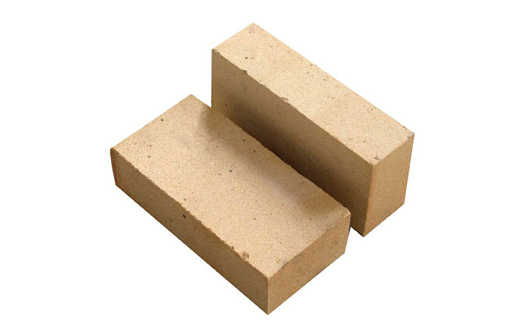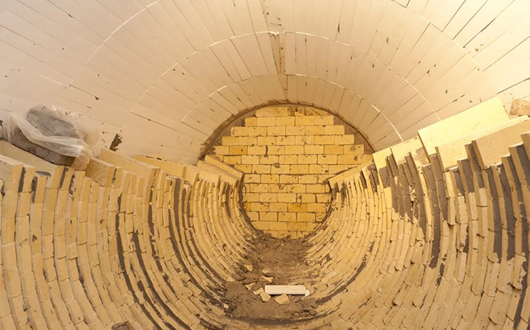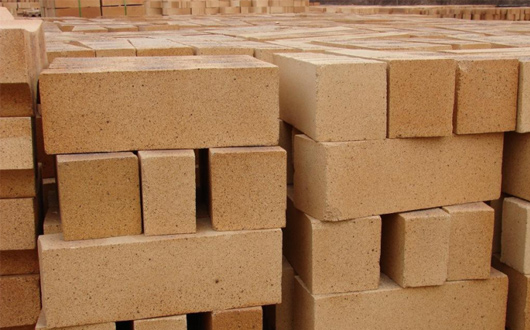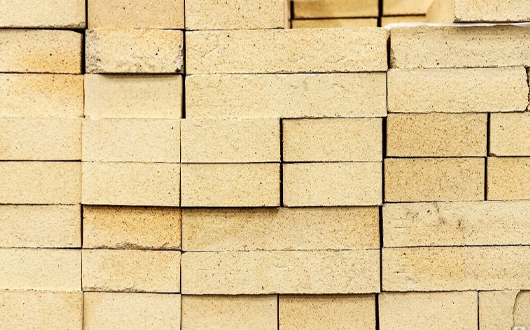Refractory brick is a ceramic material that is often used in high temperature environments because of its lack of combustibility and because it is a decent insulator that reduces energy losses. Refractory brick is usually composed of aluminum oxide and silicon dioxide. It is also called "
fire brick."
Composition of Refractory Clay
Refractory clays should contain a higher proportion of "harmless" silicon dioxide and
aluminum oxide. They should have very small amounts of harmful lime, magnesium oxide, iron oxide, and alkali.
Silicon Dioxide: Silicon dioxide (SiO2) softens at about 2800℉ and finally melts and turns into a glassy substance at about 3200℉. It melts at around 3300℉. This high softening and melting point makes it the main material for producing refractory bricks.
Alumina: Alumina (Al2O3) has a higher softening and melting temperature than silicon dioxide. It melts at around 3800℉. Therefore, it is used in combination with silicon dioxide.
Lime, magnesium oxide, iron oxide, and alkali: The presence of these harmful ingredients helps to reduce the softening and melting temperatures.
Key Features of Refractory Bricks
Refractory bricks are generally yellowish-white in color
They have excellent heat resistance and great compressive strength
Their chemical composition is quite different from that of regular bricks
Refractory bricks contain about 25 to 30% alumina and 60 to 70% silica
They also contain oxides of magnesium, calcium, and potassium
Refractory bricks can be used to build kilns, furnaces, etc.
They can withstand temperatures up to 2100 degrees Celsius
They have incredible heat capacity which helps different structures to remain stable in extreme temperatures.
Manufacturing process of refractory bricks
Fire bricks are made by various brick-making processes, such as soft mud casting, hot pressing, and dry pressing. Depending on the material of the fire brick, some processes will work better than others. Fire bricks are usually formed into a rectangular shape with dimensions of 9 inches long × 4 inches wide (22.8 cm × 10.1 cm) and a thickness between 1 inch and 3 inches (2.5 cm to 7.6 cm).
Raw material preparation:
Refractory materials: Common raw materials include alumina, aluminum silicate, magnesium oxide, silica, etc. These raw materials are proportioned according to the required properties and types.
Binder: Clay, gypsum, etc. are usually used as a binder to help the raw material particles combine and form.
Mixing and grinding:
Put the prepared raw materials into a mixing equipment for stirring and mixing to ensure that the various raw materials are fully mixed and evenly mixed.
The mixed raw materials are finely ground through a grinder to make the particles more uniform and fine.
Molding:
The mixed and ground raw materials are placed in a molding mold and formed into the shape of bricks through vibration compaction or extrusion molding.
Drying:
After forming, the bricks need to be dried, usually by air drying or drying in a drying chamber, to remove moisture from the bricks.
Sintering:
After drying, the bricks are placed in a refractory brick kiln and sintered at high temperatures to burn out the binder in the raw materials and combine the particles to form a solid structure.
The sintering temperature and time vary depending on the different raw materials and requirements, and are usually carried out under high temperature conditions above 1500°C.

Advantages of Using Refractory Bricks or Fire Bricks
Using
refractory bricks offers a ton of advantages. They are more expensive than conventional bricks due to their unique high-end insulating abilities. However, they offer some unique advantages in exchange for your extra investment. Basic Refractory Bricks Suppliers in India also ensure the supply of Magnesia Bricks in the country and they offer refractory bricks with the following advantages:
Excellent Insulation
Refractory bricks are mainly used for their incredible insulating properties. They block the penetration of heat. They also keep the structure comfortable both in summer and winter.
Stronger Than Regular Bricks
Refractory bricks are stronger than conventional bricks. That is why they are more durable than regular bricks. They are also surprisingly lightweight.
Any Shape and Size
Basic Refractory Bricks Suppliers in India also ensure the supply of Magnesia Bricks in the country and they offer customizable refractory bricks. Most manufacturers and suppliers offer customized bricks in the desired size and dimensions to buyers.
What are Refractory Bricks Used For?
Refractory bricks find application in places where thermal insulation is very important. This example includes furnaces. They are ideal for almost all extreme weather conditions. Many well-known developers even use these bricks in house construction projects. In hot conditions, refractory bricks keep the interior cool and cold conditions away. They also keep the house warm.
For household appliances, such as ovens, grills, and fireplaces, the refractory bricks used are usually made of clay that contains mainly aluminum oxide and silicon dioxide, elements that are able to withstand high temperatures. Aluminum oxide has reflective properties, while silicon dioxide is an excellent insulator. The more aluminum oxide there is in the mix, the higher the temperature the brick can withstand (an essential consideration for industrial use) and the more expensive the brick will be. Silicon dioxide has a light gray color, while aluminum oxide has a light yellow color.
It is always important to emphasize that when designing or building structures that come into contact with fire, you must pay attention to whether the materials used comply with local regulations. This is a small price to pay to avoid material losses or more serious accidents. It is always necessary to seek advice from experts and manufacturers.



